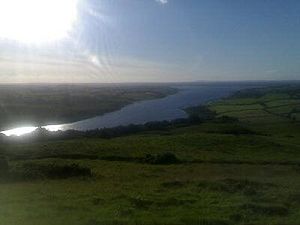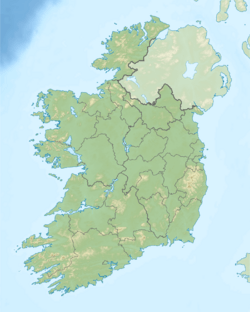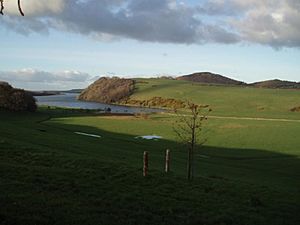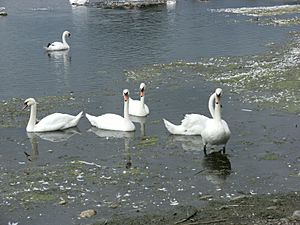Lough Derravaragh facts for kids
Quick facts for kids Lough DerravaraghLoch Dairbhreach |
|
|---|---|

Lake from the summit of Knockeyon hill
|
|
| Location | County Westmeath |
| Coordinates | 53°38′0″N 7°21′0″W / 53.63333°N 7.35000°W |
| Etymology | Irish loch dairbrech, "lake of oaks" |
| Primary inflows | River Inny |
| Primary outflows | River Inny |
| Catchment area | 559.23 km2 (215.92 sq mi) |
| Basin countries | Ireland |
| Max. length | 10 km (6.2 mi) |
| Max. width | 4 km (2.5 mi) |
| Surface area | 9.14 km2 (3.53 sq mi; 2,260 acres) |
| Max. depth | 23 m (75 ft) |
| Surface elevation | 61 m (200 ft) |
| Designated: | 7 June 1996 |
| Reference #: | 847 |
Lough Derravaragh (pronounced 'Loch Dair-var-ah') is a beautiful lake in County Westmeath, Ireland. It's located north of Mullingar, surrounded by towns like Castlepollard and Multyfarnham. The lake is part of the River Inny, which flows into it from Lough Sheelin and then continues on its journey to the River Shannon. It's a popular spot for fishing and other fun water activities.
Contents
A Look Back in Time
Ancient Settlements
Long ago, people lived around Lough Derravaragh. You can still find ringforts (old circular forts) to the east of the lake, in the hills of Ranaghan. These were homes and safe places for people many centuries ago.
Even the Vikings had strongholds nearby! Turgesius, a famous Viking leader who captured Dublin, had bases southwest of Lough Lene, not far from Lough Derravaragh.
Crannógs and Canoes
On the Kiltoom side of the lake, you might see mounds of stone. These were once part of artificial islands called crannógs. People built these islands to live on and protect themselves.
In the 1970s, something amazing was found in the lake: a dug-out canoe from the Stone Age! This shows that people have been using the lake for thousands of years.
Knockeyon Hill
Knockeyon is a hill on the southeastern shore of the lake. It rises steeply to 215 metres. Halfway up the hill, you can find the ruins of an old chapel dedicated to Saint Cauragh. There are also ruins of Saint Cauragh's Well right next to the chapel.
Amazing Legends
The Children of Lír
Lough Derravaragh is famous for its connection to the Irish legend of the Children of Lír. The story tells how the four children of King Lír were turned into swans by their jealous stepmother. They spent 300 years as swans on Lough Derravaragh. After that, they moved to the Straits of Moyle (between Ireland and Scotland) for another 300 years. Finally, they spent 300 more years on the Atlantic Ocean near Erris and Inishglora.
The Story of Saint Cauragh
Legend says that Saint Cauragh was sent away from the Kells monastery by Saint Columcille because he broke a rule. He wandered until he reached Knockeyon.
Cauragh wanted to spend the rest of his life praying and fasting there. When he became very ill and was dying of thirst, he prayed for water. Miraculously, he heard water trickling from the rock above him. He drank the water and was cured! After that, he built the chapel.
During the Middle Ages, thousands of people visited this well. They would make a pilgrimage up the hill barefoot on the first Sunday of harvest, which became known as Cauragh Sunday. After the pilgrimage, everyone would gather at the foot of the hill. They would picnic, listen to music, drink, and dance.
Protected Nature Areas
Lough Derravaragh is part of the Lough Derravaragh Natural Heritage Area. This area includes the lake itself, plus different types of wetlands, grasslands, and woodlands. There's even a small area of raised bog (a type of wetland) here. The River Inny forms the boundary in the northwest.
The Inny flows into and out of Lough Derravaragh on its northwest side. This part of the lake is wide and shallow. You'll find raised bog and "cutover bog" nearby. Cutover bog is where some peat (decayed plant material) has been harvested, but some remains.
Lough Derravaragh is a shallow lake with "hard" water, meaning it's alkaline. While there's only a small raised bog area now, it used to be a very large bog complex. Much of it has been cut for peat or turned into farmland.
Plants and Animals
The remaining bog areas have special plants like ling heather (Calluna vulgaris) and hare's tail cottongrass (Eriophorum vaginatum). You can also find different types of bog moss, like Sphagnum papillosum and Sphagnum imbricatum.
Around the lake's edges, you'll find various habitats. On the western side, there are large areas of reeds and swamps with downy birch and willow trees. There are also freshwater marshes with sedges (Carex species) and grasses like tufted hair-grass (Deschampsia cespitosa). You might also spot flowering plants like Bidens cernua and trifid bur-marigold.
The lake shore has mineral-rich soil, so you can find plants that like poor fen habitats. These include black bog rush (Schoenus nigricans) and long-stalked yellow-sedge (Carlex lepidocarpa).
Lough Derravaragh is also a Special Protection Area (SPA) for birds. This means it's an important place for certain bird species. Three special birds that need protection are the Greenland white-fronted goose, the whooper swan, and the European golden plover.
Rare plants like the Charophyte Chara denundata have been found here. You might also spot animals like the otter (Lutra lutra) and the Irish hare (Lepus timidus hibernicus) in the area.
Water Sports and Fishing
Lough Derravaragh is a great place for canoeing and other water activities. Just like Lough Ennell, Lough Owel, and Lough Lene, it's an important spot for people who love to fish. The lake has a healthy population of brown trout, making it a popular destination for anglers.
Images for kids






